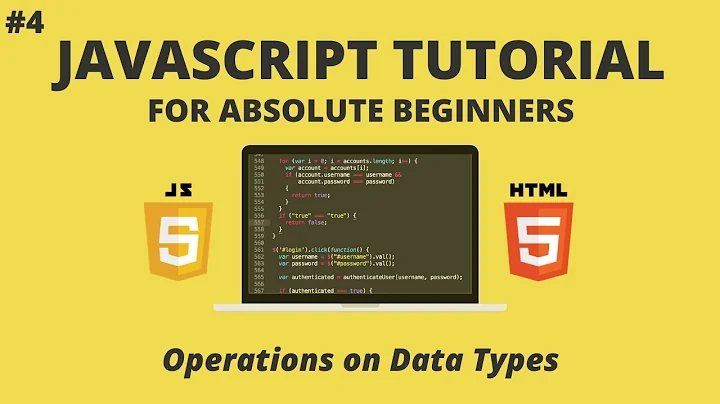Javascript AND operator within assignment
Solution 1
Basically, the Logical AND operator (&&), will return the value of the second operand if the first is truthy, and it will return the value of the first operand if it is by itself falsy, for example:
true && "foo"; // "foo"
NaN && "anything"; // NaN
0 && "anything"; // 0
Note that falsy values are those that coerce to false when used in boolean context, they are null, undefined, 0, NaN, an empty string, and of course false, anything else coerces to true.
Solution 2
&& is sometimes called a guard operator.
variable = indicator && value
it can be used to set the value only if the indicator is truthy.
Solution 3
Beginners Example
If you are trying to access "user.name" but then this happens:
Uncaught TypeError: Cannot read property 'name' of undefined
Fear not. You can use ES6 optional chaining on modern browsers today.
const username = user?.name;
See MDN: https://developer.mozilla.org/en-US/docs/Web/JavaScript/Reference/Operators/Optional_chaining
Here's some deeper explanations on guard operators that may prove useful in understanding.
Before optional chaining was introduced, you would solve this using the && operator in an assignment or often called the guard operator since it "guards" from the undefined error happening.
Here are some examples you may find odd but keep reading as it is explained later.
var user = undefined;
var username = user && user.username;
// no error, "username" assigned value of "user" which is undefined
user = { username: 'Johnny' };
username = user && user.username;
// no error, "username" assigned 'Johnny'
user = { };
username = user && user.username;
// no error, "username" assigned value of "username" which is undefined
Explanation: In the guard operation, each term is evaluated left-to-right one at a time. If a value evaluated is falsy, evaluation stops and that value is then assigned. If the last item is reached, it is then assigned whether or not it is falsy.
falsy means it is any one of these values undefined, false, 0, null, NaN, '' and truthy just means NOT falsy.
Bonus: The OR Operator
The other useful strange assignment that is in practical use is the OR operator which is typically used for plugins like so:
this.myWidget = this.myWidget || (function() {
// define widget
})();
which will only assign the code portion if "this.myWidget" is falsy. This is handy because you can declare code anywhere and multiple times not caring if its been assigned or not previously, knowing it will only be assigned once since people using a plugin might accidentally declare your script tag src multiple times.
Explanation: Each value is evaluated from left-to-right, one at a time. If a value is truthy, it stops evaluation and assigns that value, otherwise, keeps going, if the last item is reached, it is assigned regardless if it is falsy or not.
Extra Credit: Combining && and || in an assignment
You now have ultimate power and can do very strange things such as this very odd example of using it in a palindrome.
function palindrome(s,i) {
return (i=i || 0) < 0 || i >= s.length >> 1 || s[i] == s[s.length - 1 - i] && isPalindrome(s,++i);
}
In depth explanation here: Palindrome check in Javascript
Happy coding.
Solution 4
Quoting Douglas Crockford1:
The
&&operator produces the value of its first operand if the first operand is falsy. Otherwise it produces the value of the second operand.
1 Douglas Crockford: JavaScript: The Good Parts - Page 16
Solution 5
According to Annotated ECMAScript 5.1 section 11.11:
In case of the Logical OR operator(||),
expr1 || expr2 Returns expr1 if it can be converted to true; otherwise, returns expr2. Thus, when used with Boolean values, || returns true if either operand is true; if both are false, returns false.
In the given example,
var oneOrTheOther = someOtherVar || "these are not the droids you are looking for...move along";
The result would be the value of someOtherVar, if Boolean(someOtherVar) is true.(Please refer. Truthiness of an expression). If it is false the result would be "these are not the droids you are looking for...move along";
And In case of the Logical AND operator(&&),
Returns expr1 if it can be converted to false; otherwise, returns expr2. Thus, when used with Boolean values, && returns true if both operands are true; otherwise, returns false.
In the given example,
case 1: when Boolean(someOtherVar) is false: it returns the value of someOtherVar.
case 2: when Boolean(someOtherVar) is true: it returns "these are not the droids you are looking for...move along".
Related videos on Youtube
Alex
I'm a web and mobile software engineer! Passionate about ruby and javascript.
Updated on July 16, 2021Comments
-
 Alex almost 3 years
Alex almost 3 yearsI know that in JavaScript you can do:
var oneOrTheOther = someOtherVar || "these are not the droids you are looking for...";where the variable
oneOrTheOtherwill take on the value of the first expression if it is notnull,undefined, orfalse. In which case it gets assigned to the value of the second statement.However, what does the variable
oneOrTheOtherget assigned to when we use the logical AND operator?var oneOrTheOther = someOtherVar && "some string";What would happen when
someOtherVaris non-false?
What would happen whensomeOtherVaris false?Just learning JavaScript and I'm curious as to what would happen with assignment in conjunction with the AND operator.
-
icktoofay almost 14 yearsTry it. jsfiddle.net/uv6LR
-
Chance almost 14 yearssee my answer from a related post.. stackoverflow.com/questions/3088098/…
-
 Rich almost 9 yearsIn your example, if someOtherVar is undefined it will throw an error. Using window.someOtherVar will allow it to take on the second value if it someOtherVar is undefined.
Rich almost 9 yearsIn your example, if someOtherVar is undefined it will throw an error. Using window.someOtherVar will allow it to take on the second value if it someOtherVar is undefined.
-
-
 Alex almost 14 yearsAh ok. Thanks. That makes sense as, after all, it's the reverse of the OR operator.
Alex almost 14 yearsAh ok. Thanks. That makes sense as, after all, it's the reverse of the OR operator. -
ctaymor almost 10 yearsReally clear answer. The other answers left me rather baffled, but this is a very clear way of expressing it. Thank you!
-
Lucky almost 9 yearsthank you, awesome example! Help me a lot to understand && and || operators! +1
-
 Bardelman over 8 yearsThus, when used with Boolean values, && returns true if both operands are true; otherwise, returns false. (developer.mozilla.org/en-US/docs/Web/JavaScript/Reference/…)
Bardelman over 8 yearsThus, when used with Boolean values, && returns true if both operands are true; otherwise, returns false. (developer.mozilla.org/en-US/docs/Web/JavaScript/Reference/…) -
Akrikos about 8 yearsCrockford also calls it the 'guard operator' here: javascript.crockford.com/survey.html
-
Akrikos about 8 yearsI love the example. It would be great if you'd include a bit about
&&being called a 'guard' operator that's good for null checks as that's good context to have. You could even cite Douglas Crockford here: javascript.crockford.com/survey.html -
Scott Savarie over 6 yearsThank you for this answer! I'm curious how long will JS keep trying to access the deepest level property? For example, if you were waiting for a response to hit your backend, is it safe to use
var x = y && y.z? -
 Panu Logic over 3 yearsI think this answer is clearly wrong. After the above statement has been executed the value of 'variable' is the value of the expression "indicator && value" whatever that may be. So the value of the variable on the left side of the assignment is set always to something. regardless of what happens on the right side (unless an error is thrown). No?
Panu Logic over 3 yearsI think this answer is clearly wrong. After the above statement has been executed the value of 'variable' is the value of the expression "indicator && value" whatever that may be. So the value of the variable on the left side of the assignment is set always to something. regardless of what happens on the right side (unless an error is thrown). No?








